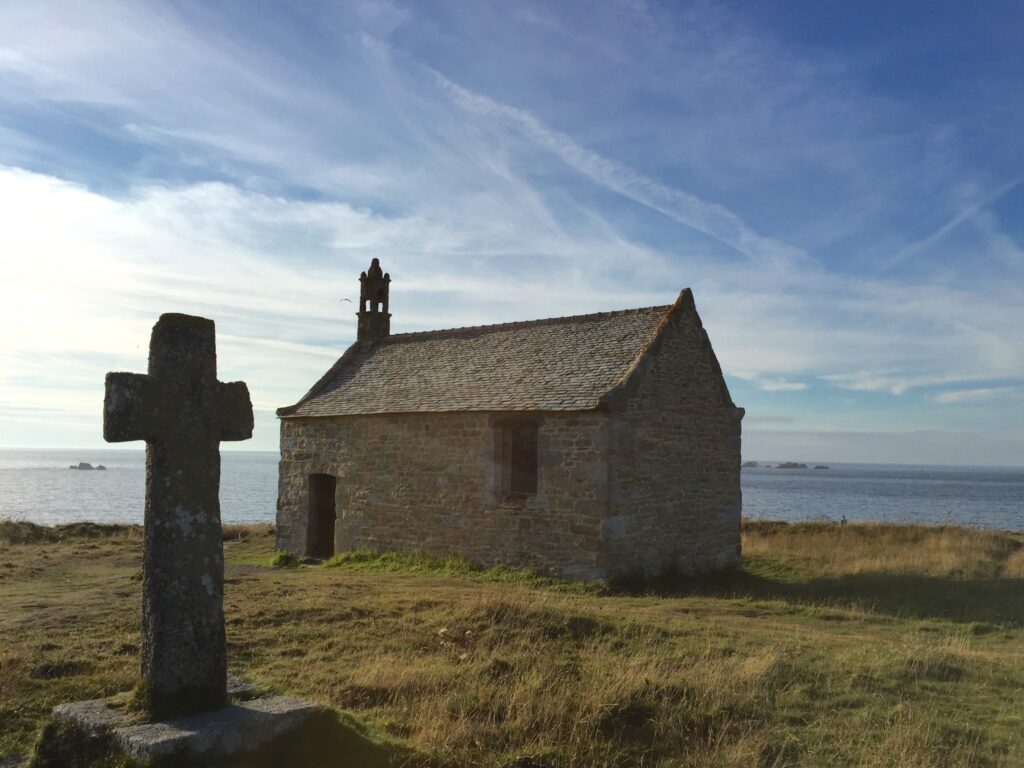Your basket is currently empty!
Journey of St. Samson that Inspired Christianity in Wales
St. Samson pursued his journey by land, but the last phase involved a crossing, from the now reclaimed estuary of the rivers Rhydeg and Alun, to Ynys Pyr across what can be a quite turbulent stretch of salt water.

Source: Vincent Desplanche | Flickr
Records of the maritime wanderings of the early Celtic Christian “saints” clearly demonstrate the major importance of the south west Wales peninsula of Pembrokeshire to the spread of Christianity through the Celtic culture world extending from Ireland as far south as Brittany and even Galicia in northern Spain.
Dozens of these men, and some women too, are documented to have travelled backwards and forwards across the Irish Sea, the Bristol and English Channels and to have used the land routes across the south west peninsulas of Wales and England to avoid the dangerous sea conditions experienced in the open seas off the “Lands Ends” of Pembrokeshire and Cornwall.
The latter years of the Roman occupation had provided a fruitful seed bed for the early western form of Christianity which took root in Wales. But, within a few decades of the Roman withdrawal, much of the eastern provinces of Britain had been over-run by pagan Anglo-Saxon settlers and the remaining Brythonic/Gaelic/Latin speaking, Romano-British communities were isolated from most of continental Europe except through the use of maritime transport routes via the Atlantic seaways.
During this period, two types of sea going vessels were current, wooden plank-built vessels capable of carrying heavy cargoes and “curraghs” built with a light weight frame covered with water proofed bull-hide. It is clear from many Celtic saintly lives that curraghs were extremely sea worthy, could be built from sustainable locally available materials and were perfectly suitable for the transport of small groups of men. In good weather, relatively small, oar driven boats like the 24 ft long Welsh Celtic Longboats, originally based on the curragh design, with a crew of five, regularly race across the 100 miles of Irish Sea from Wicklow in Ireland to the west coast of Wales.

The “Life” of the Irish St Brendan the Navigator, reports a long distance sea journey with many distant landfalls. Scholars have hypothesised that Brendan’s voyage may have reached the American continent, and marine explorer Tim Severin successfully demonstrated the viability of this hypothesis by sailing, with a crew of four or five, an authentically traditional curragh from Ireland to Newfoundland by way of northwest Scotland, the Faroe Islands, Iceland and Greenland.
So bold were these seafaring saints in their search for closeness to their God in the “deserts” of the sea that their faith supported them in taking what we might consider incredible risks. The written record tells of Celtic Christian monks who cast themselves adrift in their curragh with no oars and no sail in order to “wander for the love of the Lord” and founded monasteries at the place where their Lord directed wind and tide to set them back on land.
However, despite the risk taking behaviour shown by super devout Celtic saints, others with a more pragmatic approach to seafaring, chose the more sensible trans-peninsular land routes which avoided the particularly dangerous passages around the most exposed headlands. Pembrokeshire’s (Pen Fro/Land’s End) most south west point, the Castle Martin Peninsula is exposed to the full fury of Atlantic wave and wind conditions, powerful and dangerous tidal currents and involves many miles of navigation past a hostile, rocky and harbourless lee shore.
Landing on the safer shores of west Wales and crossing the Pembrokeshire peninsula by land avoided the dangerous journey round Pen Fro’s most exposed headland and enabled travellers to embark on a new ship at the south east coast in the relatively sheltered waters of the Bristol Channel where there were more numerous safe havens.
The records of the lives and doings of these saints are often uncertain, composed as they are of word of mouth hand downs, local legends and the concoctions of medieval religious establishments wishing to associate and legitimise themselves with the fame of long established religious pieties. However, there are some fragments and near complete “lives” which scholars identify as being more accurate because closer to the source.
One such is the life of St Samson of Dol, which has undergone several translations from late 5thC Latin into medieval Latin and then into English. However, it is believed to have been written by a family member not long after Samson’s death. If so, it is likely to have been more factually correct than many of the later, medieval lives of the Celtic saints. Scholars believe that Samson’s Life was composed in the early 600s, and that it states that he was born in Pembrokeshire around 480c B.C, about 70 years after the Roman legions withdrew from Britain.
St Samson’s life reports that his father was a citizen of the kingdom of Demetia, then consisting of Pembrokeshire and much of west Carmarthenshire, with a mixed population of local Welsh and immigrant Irish, ruled by a royal family with Irish names and an elite responsible for a large number of Irish Ogham script inscribed memorial stones. Samson’s mother was a citizen of the more Romanised South east Wales and, at around the age of five, he was enrolled into the monastic school of St Illtud at Llanilltud Fawr in the Vale of Glamorgan.
Sources suggest that Illtud himself had been born in Brittany and had emigrated to Wales and settled in the Vale after becoming ordained as a priest. It is clear that Llanilltud Fawr was a major force in the consolidation of western Christianity in South east Wales and that maritime travel was common. Samson’s “Life” reports that he graduated from Illtud’s school with a reputation for precocious austerity and theological and medical knowledge.
Following his ordination Samson travelled west to the small monastic community of Ynys Pyr (Caldey Island) lying off Tenby on the southeast coast of Pembrokeshire, which was under the leadership of Abbot Pyro. Samson’s Life reports that the journey was by land, but the last phase involved a crossing, from the now reclaimed estuary of the rivers Rhydeg and Alun, to Ynys Pyr across what can be a quite turbulent stretch of salt water. This estuary was already a hub of Celtic Christian activity, being the birthplace of St Teilo and the site of a well-established religious community, but Samson’s austerity and his love of “desert” places led him to seek the greater isolation of Caldey.
Despite Abbot Pyro’s reputation as ”a saint and a gentleman”, his life style was less austere than Samson’s, and one night Pyro drank so merrily that “owing to stupid intoxication he fell headlong into a deep pit and died in the night from his adventure”. Subsequently, the community elected Samson to be Abbot and he attempted to lead by example so that the brothers thought of him as more of a hermit than a member of their order, “fasting always from food and drink” and “never allowing his body to rest in a bed.” There are indications that the brothers found Samson’s regime rather oppressive and it is clear that he had relatively little interest in the management of a monastic community and a longing for more godly pursuits than such a bureaucratic position.
When a group of Irish churchmen, returning from Rome, visited the Caldey community Samson decided to visit Ireland in their company. Abandoning his abbotship, he crossed the Pembrokeshire peninsula to the west coast and took ship for Ireland. After sometime in Ireland, impressing the Irish clerics with his austerity and miracles, he set sail on the return journey to Pembrokeshire and Caldey.
Some versions of Samson’s Life report that, before embarking for the return journey to Caldey he had a collapsible cart and a “chariot” built, that could be dis-assembled for shipboard transport and re-assembled to transport his “books and spiritual vessels” on land. At least one commentator has proposed that the “cart” might have been used to transport a small light weight curragh for Samsons ongoing salt water travels.
The most suitable land route for the return peninsular crossing towards Caldey would have been via the deep water of the DauCleddau estuary and up the Carew River to the site of the ancient Iron Age promontory fort where the Norman Carew Castle now stands. From there a small river runs eastward and inland beside an ancient roadway suitable for Samson’s cart. This route passes a rocky outcrop suspected to be a neolithic dolmen and an unusual low land Bronze Age round barrow at Redberth. Just past this barrow a narrow “hollow way” road strikes south and uphill past a recently re-erected standing stone and a chalybeate spring. At the summit of the hill the road runs downhill again towards the northern end of the now reclaimed Rhydeg estuary, still navigable until the early 1800s. From there it would have been a short journey by water to the mouth of the estuary and the crossing to Caldey.
However, this was not the end of Samson’s travels for he soon retired from the Caldey community to pursue the life of a hermit living in a cave on the shores of the Severn estuary. After a period of extended fasting and other “austerities” he experienced a series of visions which encouraged him to resume his maritime wanderings. Samson transported his cart and chariot across the Bristol Channel to Cornwall and landed somewhere between Port Isaac and Padstow. Here he re-constructed his cart and chariot and used them to transport his boat and gear across the Cornish peninsula towards Fowey on the English Channel coast
En-route he visited a monastic community on the edge of Bodmin. However, due to his reputation for strict austerity, he does not seem to have been welcomed there, for his Life reports that the Abbot of the monastery told him that “your request to stay is not convenient, for you are better than us and you might condemn us, and we might properly feel condemned by your superior merit…. You had better go on to Europe”.
Sources other than Samson’s Life report that he did not immediately leave north Cornwall. The Life of St Petroc reports that Petroc found Samson living in a hermitage cell near Padstow on the Camel estuary where the two fell into a “disputation” which led St Petroc to evict him. Following the dispute with Petroc, Samson resumed his journey towards Fowey, during which his Life reports that he could not resist attempting the conversion of a group of pagan worshippers round a standing stone “worshipping a certain heathen idol”. This was much to their annoyance, “some being furious, some mocking and some of saner minds urging him to go away”.
Regardless of the offence he was causing Samson took an “iron instrument” and carved a cross upon the stone, after which he performed a series of miracles which, according to his Life, converted the pagans to Christianity.
Reaching the Fowey estuary, Samson founded a chapel, probably on the site where there is still a church dedicated to him, before setting sail for Brittany. This voyage included a stay on St Samson’s island in the Scillies, where he may have spent time as a hermit, and ended with him being given land at Dol, near Mont Sant Michel in northern Brittany, where he founded his own community, governed according to his austere principles and which soon became a centre of theological excellence recognised throughout northern France. Samson was elected to the Archbishopric of the region and became an ambassador and advisor to kings, but he never lost his evangelistic zeal and fondness of travel, for in his old age he undertook yet more sea journeys.
In about 557 he petitioned the local ruler for more land to expand the resources of his community and was granted some offshore islands which he visited, and that ultimately encouraged him to sail onwards to the Channel Islands. In around 560 AD, he landed on Guernsey at the natural harbour of the area which still bears his name. Breton and Guernsey sources confirm that he converted the pagan natives to Christianity, built the Island’s first church, now dedicated to him, and has long been recognised as the Patron Saint of Guernsey. Samson returned to Dol where he died in around 565AD and where his remains lie in the Cathedral of St Dol.
The conversion of the remaining pagan Channel Islands can also be linked to St Samson’s influence, being the work of two more Welsh born Celtic Christian saints influenced by Samson.
St Magloire, born in Wales and also educated at St Illtuds monastic school in the Vale of Glamorgan, is reported to have been one of Samson’s nephews. Magloire’s life reports that he had been one of Samson’s companions on his journey from Wales to Brittany and to have succeeded him as Archbishop of Dol. Magloire is recorded as the converter of the citizens of the Island of Sark, of which he is the Patron Saint, and to have contributed to the conversion of Jersey.
St Tugdual (Tudwal in Welsh) is reported to have been born in Cornwall, sailed by way of Pembrokeshire, to Ireland where he received his religious education, then sailed to north Wales and to have lived for a while as a hermit on St Tudwals Island off the coast of the Lleyn/Llyn peninsula. After some years he travelled down the Cardigan Bay coast to Pembrokeshire where there is a church dedicated to him at Llanstadwell on the shores of the Milford Haven. Following a similar route to that taken by Samson and Magloire he travelled across Cornwall and sailed for Brittany where he too founded a monastery before embarking on a mission to convert the Channel Island of Herm. There is still a small chapel dedicated to him and he is recognised as the Patron Saint of that Island.
The details of the maritime and trans-peninsular travels of these Saints have been recorded, by their educated and literate brethren of the Celtic Christian monastic schools, intent on recording the deeds of their saintly predecessors. It is, however, important to remember that travellers such as Samson, Magloire and Tudwall and their named and anonymous colleagues and brothers were using the same routes as the multitude of unrecorded traders and bards, thinkers and story tellers and that all of them were contributing to the creation of a post Roman Celtic Christian culture which made a lasting impact on the evolution of Western Europe. It is thanks to the lives of the Celtic Christian saints that we can gain an insight in to how this culture travelled backwards and forwards across the trans-peninsular routes and the western seaways of the Celtic lands.
More from Welsh Histories
Welsh Histories is a Welsh history celebrating platform which looks to promote all aspects of Welsh history. Though we focus predominantly on native Welsh history, we do also share the non-native aspects from time to time. You can follow us on Facebook; Instagram or Twitter for more. A reader? We also have our very own Welsh Histories Shop where we sell our Welsh Histories Magazine. Diolch yn fawr iawn and keep enjoying Welsh Histories.
Tim Deere-Jones lives in South Pembrokeshire in close proximity to both the Irish Sea and the Bristol Channel coasts. Tim studied at the Dept of Maritime Studies, University of Wales: Cardiff where he achieved a BSc (Hons). He has subsequently worked as a Marine Pollution Researcher and Consultant on the coasts of all of the Celtic regions except Galicia, and led University and College field trip sessions in and around Pembrokeshire. Tim has written extensively on marine issues for many publications including The Ecologist magazine and the BBC Wildlife Magazine.
Tim has lived afloat at sea, sailed, raced Celtic Longboats and canoed extensively around the coasts of south west Wales and has had an active interest in, and engagement with, the anthropology and archaeology of coastal peoples.

